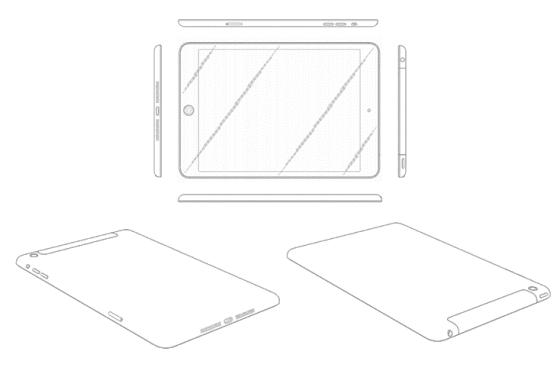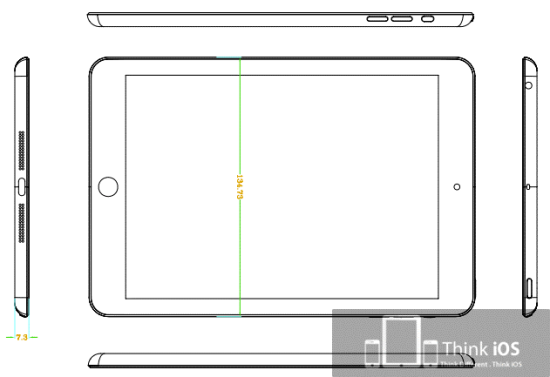Apple’s iPad Mini registrable despite prior publication


In Apple Inc v The Registrar of Patents, Designs and Trademarks (MCA 15713-04-15, June 25 2017), the Jerusalem District Court has overturned a decision by the Registrar of Patents, Designs and Trademarks which had rejected Apple’s Design Application 53627 with respect to the design of a tablet device on the grounds of prior publication.
In 2013 Apple applied in Israel for the registration of a design for its iPad Mini in Class 14, in respect of “recording, communication or information retrieval equipment”. Apple claimed priority from a US design patent application (29/429,478) dated from 2012 (see below).
The examiner refused the application on the grounds that it was ineligible for registration under Section 30(1) of the Patents and Designs Ordinance 1924 due to prior publication of the design. The prior publication was presented to the examiner after Apple was requested, as part of the examination procedure, to disclose any known publication of the design prior to the priority date. In response, Apple indicated one prior online publication on a website called ‘macrumors.com’, an unofficial website that consolidates rumours related to Apple products, which mentioned that another website, ‘ThinkiOS.com’ (via ‘9to5Mac.com’), showed drawings of the iPad Mini. It was further stated in the publication that the description of the design was based on mere speculation. Apple argued that the authenticity of the statements were doubtful and, in particular, claimed against the accuracy of the information relating to the date of publication. Apple further argued that the publication was not made by Apple or with its consent and for that reason should not be considered as prior publication.
(picture taken from the ThinkiOS website)
Following the examiner’s refusal of registration, a hearing was held before the registrar. In the hearing, Apple further argued that the publication did not disclose the design and that there were substantial differences between the design and the prior publication.
The registrar refused registration, holding that it was irrelevant whether the prior publication was discovered by the examiner or was brought to her attention by the applicant.
The registrar also held that meticulous examination of the prior publication showed no significant differences between the designs and it was clear that the design subject of the application was similar to the design and that most of the details had been published in the prior publication.
On appeal, the Jerusalem District Court overturned the registrar’s decision. The court based its ruling on Registrar’s Letter MN 69 and the registrar’s decisions in Sertic Venja and Tequila Cuervo, according to which examination of prior publication must, first and foremost, determine in close proximity the date of publication.
The court held that:
- The fact that an applicant reports prior publication, due to its duty to a bona fide procedure, does not mean that the applicant grants absolute credibility to the date appearing in the publication simply as a result of reporting it. The court further rejected the registrar’s approach that a report by the applicant should be considered an admission by the applicant, since such holding may result in a negative incentive to report prior publications;
- At the least, the report of prior publication requires additional examination as to whether the publication can be attributed with required credibility. Without such examination the publication on a website should not be considered as prior publication revoking the novelty of the design subject of the application. In this case, due to the nature of the website, the fact that it is an unofficial website, its declared goal to provide any rumour from any source, the court held that the prior publication was not reliable and could not be trusted.
- Further, due to differences between the publication and the design, which the court deemed significant, it was held that, regardless of the publication date, the publication should not be considered prior publication. In particular, the court noted that in the propounded design there was a distinctive back panel which was absent from the publication and that the corners of the compared devices were different.
- Finally, the court also referred to the examination procedure and more specifically to the laconic rejection of Apple’s arguments, and held that by rejecting the arguments without providing a proper explanation the examiner had not complied with the duty to provide reasoning as required of any administrative authority.
Accordingly, the court overturned the registrar’s decision and costs of IS 10,000 were ordered in favour of Apple.
In connection with this case, see the previous decision of the Israel Patent Office rejecting Apple’s trademark application for iPhone 4 (https://www.worldtrademarkreview.com/Daily/Detail.aspx?g=86a70aa5-59fe-45c4-8d3e-27da0463c024).
This article first appeared on WTR Daily, part of World Trademark Review, in July 2017. For further information, please go to www.worldtrademarkreview.com.
This article is provided for general information only. It is not intended as legal advice or opinion and cannot be relied upon as such. Advice on specific matters may be provided by our group’s attorneys.


